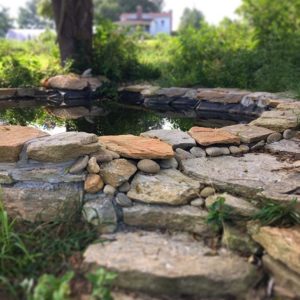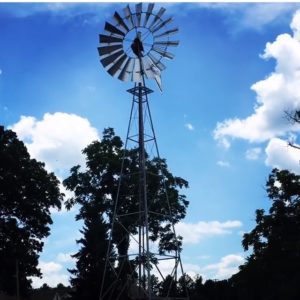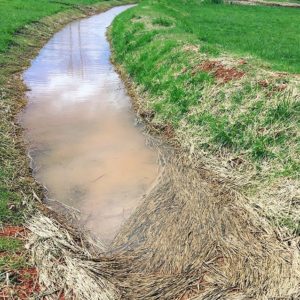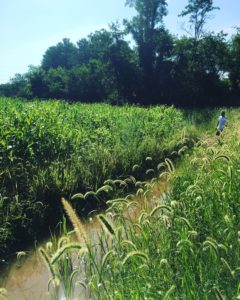By Patryk Battle, Living Web Farms Director
Part of Living Web Farms mission is innovation with the goal of ever increasing our land’s and our farming operation’s resilience. Over the course of the last year or so we’ve undertaken several new projects with this end in mind. In the future, I hope to describe some other innovations such as our soldier fly production unit and our passively aerated windrow composting system. But for now, I want to cover the most ambitious and for certain our largest innovation/installation. This is our Grandview Farm’s extensive new system of water management earthworks, conceived, designed, and installed by John Henry Nelson, of the Stone and Spade Permaculture Design and Installation Company. This project started with our original concept, which was to install a pond that would collect water from the extensive roof area covering the Grandview Biochar and Greenhouse Complex. Expanding on this concept John designed a water management/wetland plan for the entire Grandview property. Over the last year, he has installed three major ponds, a couple of small settling ponds and a remarkable system of swales and berms and wetlands which collect, filter and channel almost all of the rainwater that would otherwise run off our land during major rain events. The system is anchored by a million gallon Collection Pond next to our greenhouse. Fortuitously this placement puts the Collection Pond at the lowest place on the property.
Protected by a wetland installed between this pond and the biochar facility’s parking lot this pond includes a fish lock to facilitate the harvesting of fish. Our new Collection Pond receives the water collected from the roofs of the biochar greenhouse complex, and the above-described swale berm wetland system. The Collection Pond is projected to collect over a million gallons a year. Another key component of this system is a “Saddle” Pond. Situated at the highest point on the Grandview property, the “Saddle” Pond likewise, has a million gallon capacity. John’s installation connects the Saddle Pond by an underground pipeline to the Collection Pond. Using a windmill and a backup solar powered pump his system moves water from the Collection Pond up to the Saddle Pond. From the Saddle Pond, water can be distributed by gravity to all of the plant and animal operations on our Grandview farm.
There is a third pond installed in a 3.5-acre field which is separated from the main property by Grandview Lane and therefore must have an independent swale-berm pond collection system. This pond has a capacity of approximately 100,000 gallons. This pond is connected by a pipe that goes under Grandview Lane to the Saddle Pond. Our always industrious, creative and inspired biochar crew has already created a mobile solar power unit which will be able to power a solar pump for this more remote pond. We will use this pump on those occasions when the hundred thousand gallon pond reaches capacity, and we need to move excess water to the Saddle Pond.
Installed at a level grade, the swales are designed to first and most importantly channel water into the aquifer. Previously during intense rain events, water rushed off our property and even possibly at times contributed to downstream flooding. Since our swales have no slope water only moves gently to the Collection Pond when the water holding capacity of the land is exceeded. Such saturation causes the swales to fill up . The end of the level grade swale system furthest from the Collection Pond has no outlet. Only the end of the swale system closest to the Collection Pond has an outlet. Once the swales have filled during excessive rains, they must overflow at this end through a small settling pond, which then overflows, channeling the water through a wetland installation down to the Collection Pond.
Since the fields at Grandview are all covered by either pasture, or in the case of the 3.5-acres multi-species no-till planted cover crops/vegetable crops, there is virtually no erosion. However, during intense rain, there will always be some stripping of small amounts of topsoil and organic matter. The swale/ settling pond component of this system is designed to intercept this bit of erosion before it leaves the property. Hence the swales will become increasingly rich, as they gather sediment and we will be able to harvest sediment from the settling pond. Furthermore, the berms will stop wind blown leaves each fall. These leaves will settle into the swales further enhancing the fertility of the swales. Water tolerant plants such as Silphium Perfolaitum or Cup Plant can be planted on the uphill side of these ever more fertile swales, and they will eventually colonize the swales converting the captured fertility into superior animal forage. Meanwhile, because so much water is channeled directly beneath the berms, they are ideal sites for silvo pasture plantings.
So far we have installed mulberries, alders (they fix more nitrogen than legumes, and their leaves are excellent forage for animals) apples, pears, persimmon, pawpaw, and serviceberry. This initial planting is only a beginning. Eventually the berms will be a diverse collection of human food and animal forage crops, inter planted with bio- accumulators such as comfrey, medicinal plants such as yarrow, and culinary herbs such as oregano. We will also, as always, plant a great diversity of farmscaping plants and pollinator habitat.
With regards to the fruit plantings, we have intentionally planted more than we are likely to be able to keep up with harvest wise. Our hope is that by creating great abundance, we will ensure that we get fruit despite bird and squirrel pressure. Also, the fruit we miss which drops to the ground will be relished by our grazing sheep, chickens, and cattle.
Since the ponds are not yet ready for stocking, and I have no expertise in the realm of aquaculture, I’m not going to attempt to describe this piece in any detail. I can however reassure readers that we will not be feeding Purina Fish Chow or any similar products to our fish. To train the fish to the fish lock, we will regularly feed them small amounts of soldier fly pupae in the fish lock. Otherwise, we will be stocking only modestly with fish species that naturally occur in our region’s pond wetland systems. For the most part, the fish will be left to rely on the natural pond/wetland food web for their sustenance. Their populations should expand as the pond ecology deepens and diversifies. We will be planting the pond edges with this goal in mind.
Hard to imagine? You don’t have to. On Saturday, August 19th John Henry Nelson will be presenting on Permaculture Earthworks and Farm Wetland Ecosystems here at Living Web Farms. Weather permitting, this will include a tour of the entire system of ponds,wetlands, swales, berms, windmill and plantings. To register and to learn more, click here.
I’m looking forward to it and hope to see you there!



